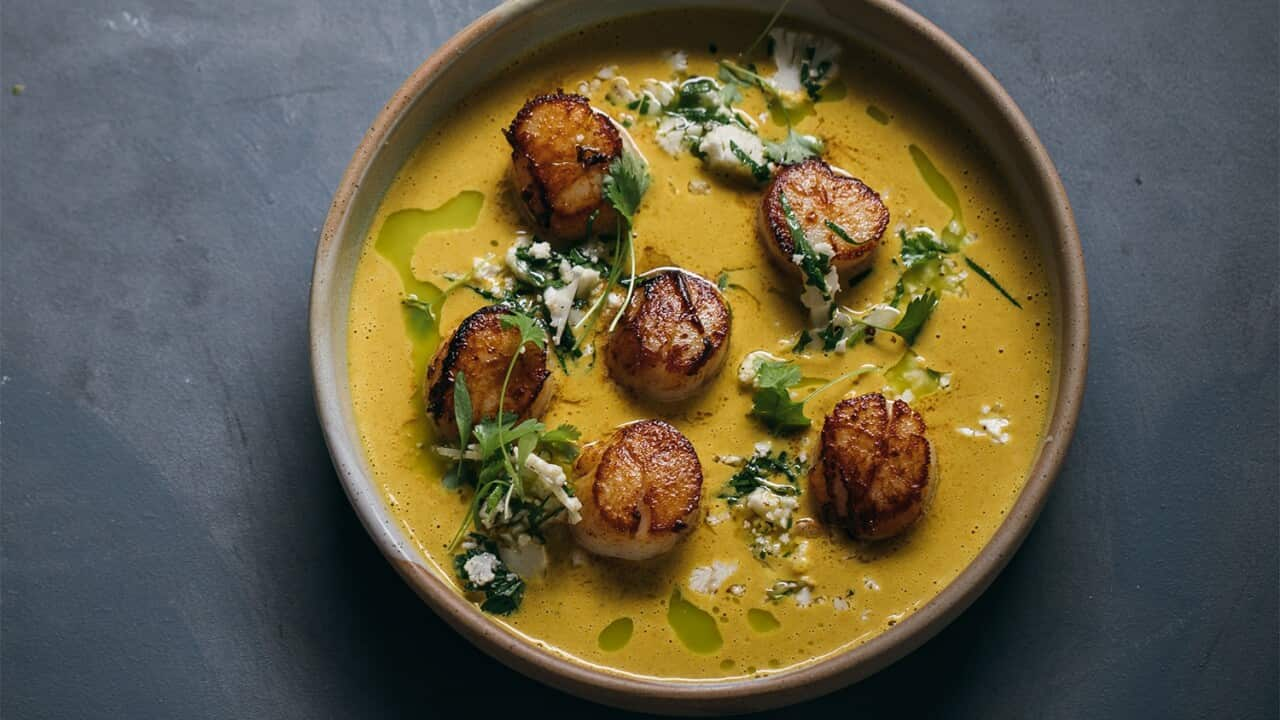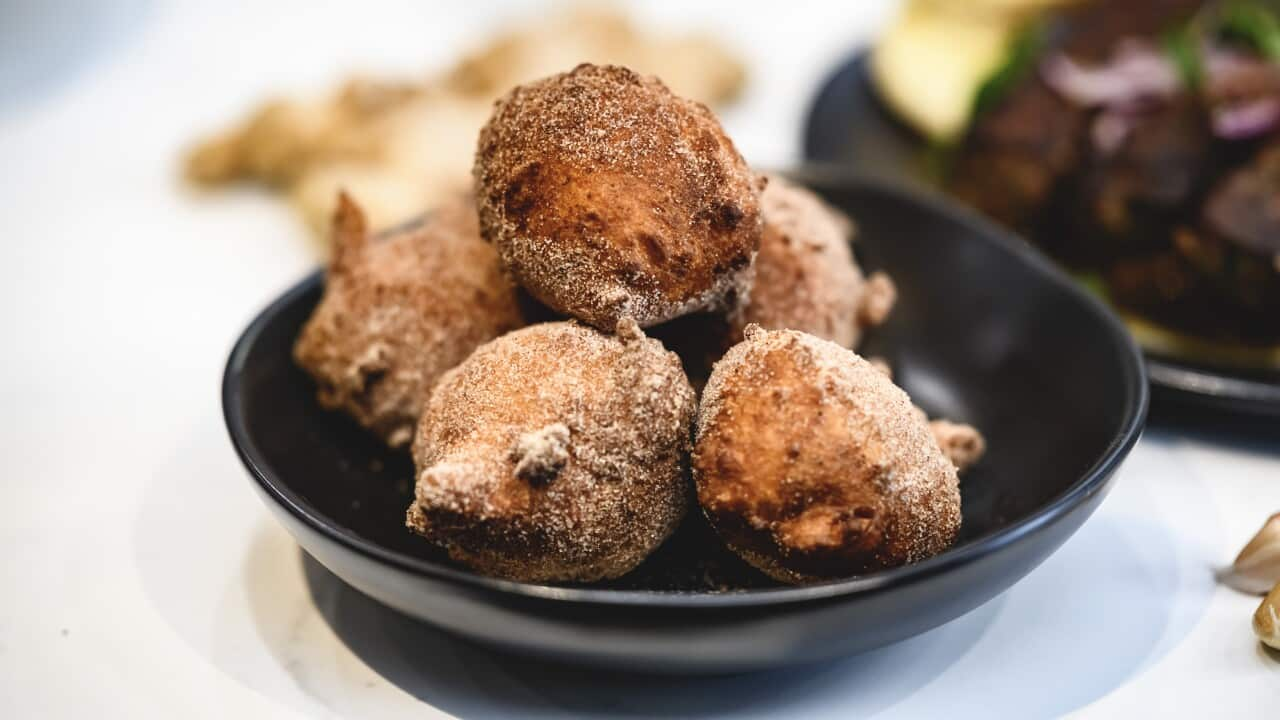--- airs weeknights on SBS Food at 7.00pm and 10.00pm, or stream it free on . ---
Clayton Nelson of Rottnest Island Scallops is serious about being a responsible fisherman. His one-trawler fleet fishes for scallops eight weeks a year, tops — and that's if he decides to go out: a collapse in the scallop population meant he didn't land one catch between 2012 and 2016.
During the season, he only fishes four days a week and doesn't go out on weekends, public holidays, or any other occasion that might draw recreational fishermen to the water. Last year, the 16 tonnes of scallop he landed was, according to Nelson, a fraction of what the fishery was capable of supplying.
SCALLOP STIR FRY

Scallops, bacon and asparagus
However, perhaps most telling: Nelson is the only fisherman who commercially catches Rottnest Island scallops after he bought all the fishing licenses in the South West Trawl Managed Fishery, the area in which he operates. It was a decision based not on greed, but on the future.
"It was a significant investment," says Nelson, who launched Rottnest Island Scallops in 2010. "But the idea of having a boutique, seasonal fishery on the doorstep of Western Australia's capital city that produces a beautiful product: I don't think there's a value on that."
The idea of having a boutique, seasonal fishery on the doorstep of Western Australia's capital city that produces a beautiful product: I don't think there's a value on that.
Equally as important as Nelson's conscience is the winged trawling net he uses. Made of lightweight Kevlar, the net floats above the seabed and trails a light stainless steel chain that moves across the ocean floor, causing scallops to burst out of the sand and into the net.
"If you go back [to the fishing area] the next day, you can't see that you've been there," says Nelson.
The nets offer a gentler alternative to the metal dredges typically used by scallop fishermen. Attached to trawlers and dragged across the ocean floor, these dredges use sharp so-called 'teeth' to penetrate the substrate and dig up the scallops, as well as the seabed. What remains isn't always a pretty sight, but since the advent of commercial scallop fishing in Tasmania (1910s) and Victoria (1970s), dredging has been the industry's go-to method. Thankfully, more and more scallop fishermen are using alternative, lower-impact methods of fishing. South Australian Paul Pollaco, for instance, hand-dives for Kangaroo Island queen scallops, instantly recognisable for their electric purple roes, while others are in the process of switching from dredges to net-based systems. Some are making the change for the environment's sake. Others are looking at it as a business decision.
Thankfully, more and more scallop fishermen are using alternative, lower-impact methods of fishing. South Australian Paul Pollaco, for instance, hand-dives for Kangaroo Island queen scallops, instantly recognisable for their electric purple roes, while others are in the process of switching from dredges to net-based systems. Some are making the change for the environment's sake. Others are looking at it as a business decision.

Australian fishermen are turning to more sustainable practices when fishing for scallops. Source: Supplied
Seafood consultant John Susman says, "When you dredge a scallop, there's a propensity for them to drown because they get pulled in with mud and whatever else [is on the ocean floor] and they can drown quite quickly." (Fun fact: Susman got his start in the Australian fishing industry in 1984 as a 20-something hand-diving for scallops in Coffin Bay and hand-selling them to Sydney chefs such as Neil Perry, Stefano Manfredi and the late Tony Bilson.)
"If the animal's swimming and in motion, it's in a much better state and there's a much higher probability that you're going to land the fish live, which gives you so many more options in terms of how you look after it."

In 2017-18, Australian fishermen brought in 7,732 tonnes of scallop, valued at $25 million. Source: Supplied
SUSTAINABLE SEAFOOD CHOICES

How to swap out your seafood for more sustainable choices
In Australia, three main scallop species are fished commercially: the Tasmanian scallop, the saucer scallop and the queen scallop. According to the most recent data from the Australian Fisheries Research and Development Corporation, in 2017-2018, Australian fishermen landed 7,732 tonnes of scallop with a value of $25 million.
Although it's possible to buy live whole scallops during the various scallop seasons around Australia, scallops are usually sold frozen, either shucked or left on the half-shell. While one might hear the occasional whisper about scallops being soaked in water to increase weight or "scallop" that's been cut from other white-fleshed seafood, Australian scallop these days is a story of quality over quantity.
Susman explains, "Many scallop fishermen have identified that the historical game of just trying to have the lowest cost of production and using all means fair and foul is actually uncompetitive against imported products, so why not go the other extreme and try to produce the highest quality that you can and get the most money for them?"
COOK UP SCALLOPS WITH ADAM LIAW

Scallops with curried cauliflower purée
While classically trained French chefs have a fondness for pairing scallops — coquille St Jacques in Gallic — with cream sauces, modern-day cooks tend to strip things back when serving scallop, to make the most of its sweet, oceanic flavour. In his Rockpool Bar & Grill cookbook, Neil Perry writes, "fresh scallops need nothing more than a squeeze of fresh lemon, a drizzle of extra virgin olive oil, a sprinkle of sea salt and a grind of pepper, then straight down the hatch."

More and more scallop fishermen are using alternative, lower-impact methods of fishing. Source: Supplied
ANOTHER MEAN SCALLOP RECIPE

Scallops with kombu butter and lemon
On a camping trip, Aaron Turner of Igni restaurant in Geelong, Victoria, discovered the scallop's roe, chopped and mixed with oil and salt, made an excellent condiment for scallops roasted whole in the fire. Veteran Japanese chef Toshi Oe of Sydney's Sushi Oe, meanwhile, would take a West Australian or Queensland scallop over anything from Hokkaido.
Oe says, "The Australian scallops I've been getting have sweetness, texture and a real scallop taste. They have firmness unlike the Hokkaido scallop, which can feel a little soft."
In addition to a nigiri-style sushi seasoned with a dab of wasabi and soy sauce, Oe also serves an aburi-style preparation where he blowtorches the scallop after briefly marinating it in nikiri, Oe's own unique combination of soy sauce, kelp and mirin.
Photography by Max Veenhuyzen.









